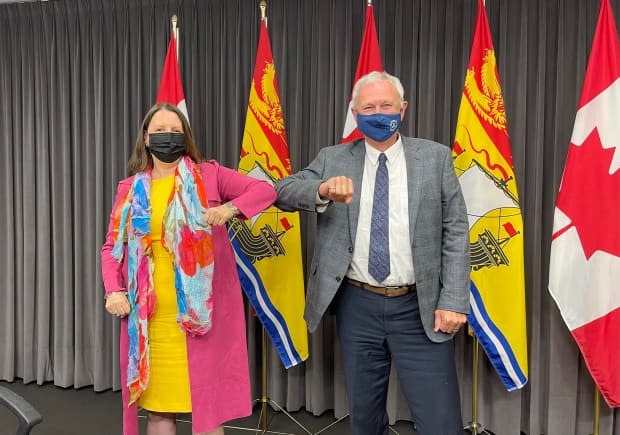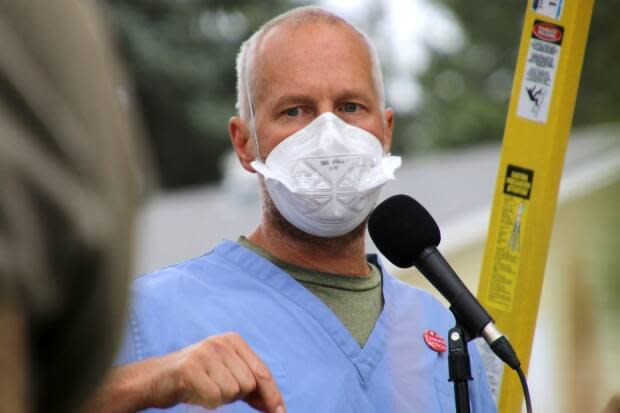Miscalculations and misinformation played role in July decision to drop COVID restrictions

An earlier than planned lifting of COVID-19 restrictions by New Brunswick in late July was based in part on a series of miscalculations, including an erroneous assessment that Alberta's early opening was going well.
But the New Brunswick government isn't acknowledging the loosening was a mistake or played a role in its current outbreak of COVID cases.
"Given the facts, I'd certainly do the same thing again," Higgs told reporters this week about easing mask, distancing and interprovincial travel restrictions July 31.
"I don't regret the decision," he said.
New Brunswick has been suffering record numbers of active cases of COVID-19 including increased hospitalizations and this week was forced to reintroduce mandatory indoor mask wearing, which was dropped as a public health measure just seven weeks ago.
The loosening of rules back in July occurred even though conditions originally set by the province for that change had not been met.
In May, Higgs and Chief Medical Officer of Health Dr. Jennifer Russell laid out a plan for ending pandemic restrictions that were supposed to be triggered only when 520,000 New Brunswick residents became fully vaccinated against the virus with two doses, 75 per cent of those eligible at the time.
Based on vaccination rates in May, Higgs estimated that threshold would be reached somewhere around August 2nd and he vowed if it wasn't, the province would wait as long as necessary to protect public health.
"If we don't hit that target then our openings will be delayed so if individuals decide they are going to forgo taking the vaccines and we miss our targets, our opening dates will all move accordingly," said Higgs about the importance of the vaccination goal.
"It is all dependent on reaching our vaccine targets so that we know our citizens are protected and that is paramount to any of this being achieved."
But two months later, with New Brunswick still 79,000 second dose vaccinations short of its target, the province declared waiting was no longer necessary.

At a July 23 news conference, Higgs and Russell said other provinces with lower vaccination rates who had already lifted restrictions were not encountering problems and, although vaccinations were behind schedule, in New Brunswick they were progressing rapidly enough.
Russell told reporters she was satisfied, given a review of Alberta's experience following the lifting of restrictions in that province July 1, it was safe to do the same in New Brunswick on July 31.
"We have seen in other jurisdictions, such as places in Alberta where they lifted their restrictions... they've continued to increase their vaccination rates and they are continuing to see their case numbers go down and their hospitalization rates go down, so they are trending in the right direction," said Russell.
But that is not what was happening in Alberta at the time, with medical and science professionals there already warning of a calamity developing.
Alberta cases were rising quickly
"Sure as heck looks like we are in the throes of early exponential growth. But man, I hope I'm wrong," Calgary emergency room physician Dr. Joe Vipond tweeted on July 21, two days before New Brunswick claimed all was well in Alberta.
Vipond, an outspoken critic of the handling of the pandemic in his province, wasn't wrong in his July 21 assessment. Active COVID-19 cases in Alberta exploded from 600 at the time to 20,600 this week in a steady two month long escalation of its COVID troubles.
In an interview, Vipond said any serious evaluation of Alberta's COVID-19 numbers around July 23 would not have given comfort to any province thinking of following a similar path.
"Objectively, the first sign of trouble was two days after [the Calgary] Stampede," said Vipond of the resurgence of COVID following the July 18 end of the iconic annual Alberta celebration.
"If you were only looking at [Alberta] government news releases, you probably wouldn't see that."
Cases in Alberta on July 23 were low but they were rising, not falling. More significantly, the delta variant was beginning to assert itself in the province, according to Malgorzata Gasperowicz, a developmental biologist at the University of Calgary.

"In overall cases, the growth started to go up on July 18th, so on July 22nd we had already four days of constant growth of overall cases," said Gasperowicz about the situation around the time of New Brunswick's news conference.
But overall case numbers were not the significant development, according to Gasperowicz, who said an emerging "undercurrent wave" of the delta variant was a more worrying event occurring inside Alberta's growing numbers.
Those delta variant cases, she said. had been growing daily since July 12 and had settled into a stable "exponential" growth trajectory by July 19. Had she been giving New Brunswick advice at the time, Gasperowicz said she would have told the province to be wary of following Alberta's lead.
"I would say at the time our situation doesn't look good. Our new cases are going up and especially the new variant, so the situation is not under control." she said.
Last week, Alberta's Chief Medical Officer of Health Dr. Deena Hinshaw acknowledged the province's early opening had allowed cases to run wild.
"I think that trajectory was set when we removed all the public health restrictions at the beginning of July," Hinshaw said.

A request for information from the New Brunswick Department of Health on Tuesday about why the province claimed Alberta's COVID-19 situation was improving in late July received no reply.
Dean Karlen, a physics professor at the University of Victoria is a member of British Columbia's independent COVID-19 Modelling Group and in an email said no matter what was happening in Alberta in July, New Brunswick should have been looking at multiple jurisdictions to chart a path forward. He said that would have shown the need to toughen reopening plans, not water them down.
"In May, before the strength of the delta variant was understood, a target vaccination level of 75 per cent was a reasonable goal," said Karlen.
"By late July, however, it was apparent in many jurisdictions that the delta variant was capable of producing very rapid growth in cases in well–vaccinated populations."
But misjudging the situation in Alberta was not New Brunswick's only misstep in deciding it was safe to open early.
The province also overestimated the rate at which New Brunswick residents would line up for vaccinations after restrictions were dropped.
Higgs said in July the province expected 40,000 residents "if not higher" to line up for second dose vaccinations in the week before restrictions fell, but fewer than 30,000 did. Numbers fell further from there.
It eventually took until the end of August before the original reopening target of fully vaccinating 520,000 people was reached.
This week Higgs acknowledged those sluggish vaccination numbers had more people unprotected longer than the province accounted for in its planning.
"That was a disappointment, the vaccination levels dropped right off," said Higgs.
Still, neither Higgs nor Russell would say directly whether New Brunswick's early lifting of COVID-19 restrictions contributed to the current outbreak.
"We can't really know for sure," said Russell on Monday.

